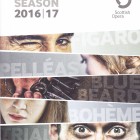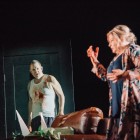Duke Bluebeard's Castle 2017Scottish Opera
Read more about the opera Duke Bluebeard's Castle
Scottish Opera's 2016/17 mainstage season opened with a revival of Sir Thomas Allen's excellent production of The Marriage of Figaro, first mounted in 2010. The company's first Philip Glass production, marking his 70th birthday, was his adaptation of Kafka's The Trial. The other new stagings included Pelléas et Mélisande, which the company had not mounted in forty years. Duke Bluebeard's Castle appeared in tandem with a new piece with music by Lliam Paterson - The 8th Door. A new staging of La bohème ends the season, with a potentially interesting 1920s treatment. The medium scale work, touring smaller venues in the autumn, was a new treatment of The Elixir of Love. A highly successful new departure was the enterprisng scheme to present Sunday afternoon concert performances of rare works - by Mascagni (L'amico Fritz), Debussy (L'enfant prodigue), Rossini (La scala di seta) and Puccini (Le villi).
To make a full evening in the theatre, the Bartók opera has, over the years, been tried in a number of combinations. The Hungarian State Opera and Ballet, who have twice brought it to the Edinburgh Festival, have both times tied it with Bartók ballets (The Miraculous Mandarin and The Wooden Prince). Other companies have given us Stravinsky (the ballet Petrouchka or Oedipus Rex) or Schoenberg (Erwartung). This time a piece was composed specially to accompany Bluebeard, conceived jointly by the director Matthew Lenton and the composer Lliam Paterson. This turned out to be a very interesting departure, making a huge impact in musical terms, even if opinions were divided over its merits as drama.
The fundamental difficulty with Bluebeard's Castle is that it is acknowledged to be a wonderful composition for large orchestra, perhaps Bartók's masterpiece. However there is little action, and the use of the term 'symbolist' seems to have been taken to mean that there isn't supposed to be. Most stagings rely on wide open spaces (not very claustrophobic) and a range of lighting effects varying from stygian gloom to dazzling brightness, with the occasional splash of colour.
Matthew Lenton's enterprising direction threw most of this away, setting the piece in a rather shabby suburban environment (no 'Duke' in this title). There was a small stage within-a-stage, which had a desk with computer to the left, a sofa to the right, a book case (not many books) at the rear. Of course there was some symbolism - at least we hope those nasty blades bursting out of the sofa were symbolic - with plantlife flowing out of the desk. The happy couple were fairly miserable right from the start, but where most interpreters seem to just stand around, these two really created flesh and blood characters going through torment. There was a great visual coup at the climax. The massed brass choirs were hidden in the dress circle boxes - creating a superb aural spectrum - and as those amazing chords burst out, the rear wall was blasted apart.
Siân Edwards has shown herself to have a masterly touch with great works of the twentieth century and her command of this piece was simply glorious. The Orchestra of Scottish Opera can rarely have played better, revealing all sorts of glowing colours in the orchestration. The pairing of Karen Cargill and Robert Hayward was certainly a high-octane one and provided a very dramatic combination. Until twenty or thirty years ago, performances of this work were only sung in Hungarian if native speakers were available. Non-Hungarians have been learning the roles for some years now, but they often sound unconvincing, as though they have learned the sounds, but not necessarily lived with the meaning. Here, however, it genuinely seemed as though these two great artists were living every syllable.
Performance Cast
- Duke Bluebeard
- Judith Bluebeard's new wife





